Altan T. Metal Forming Handbook
Подождите немного. Документ загружается.

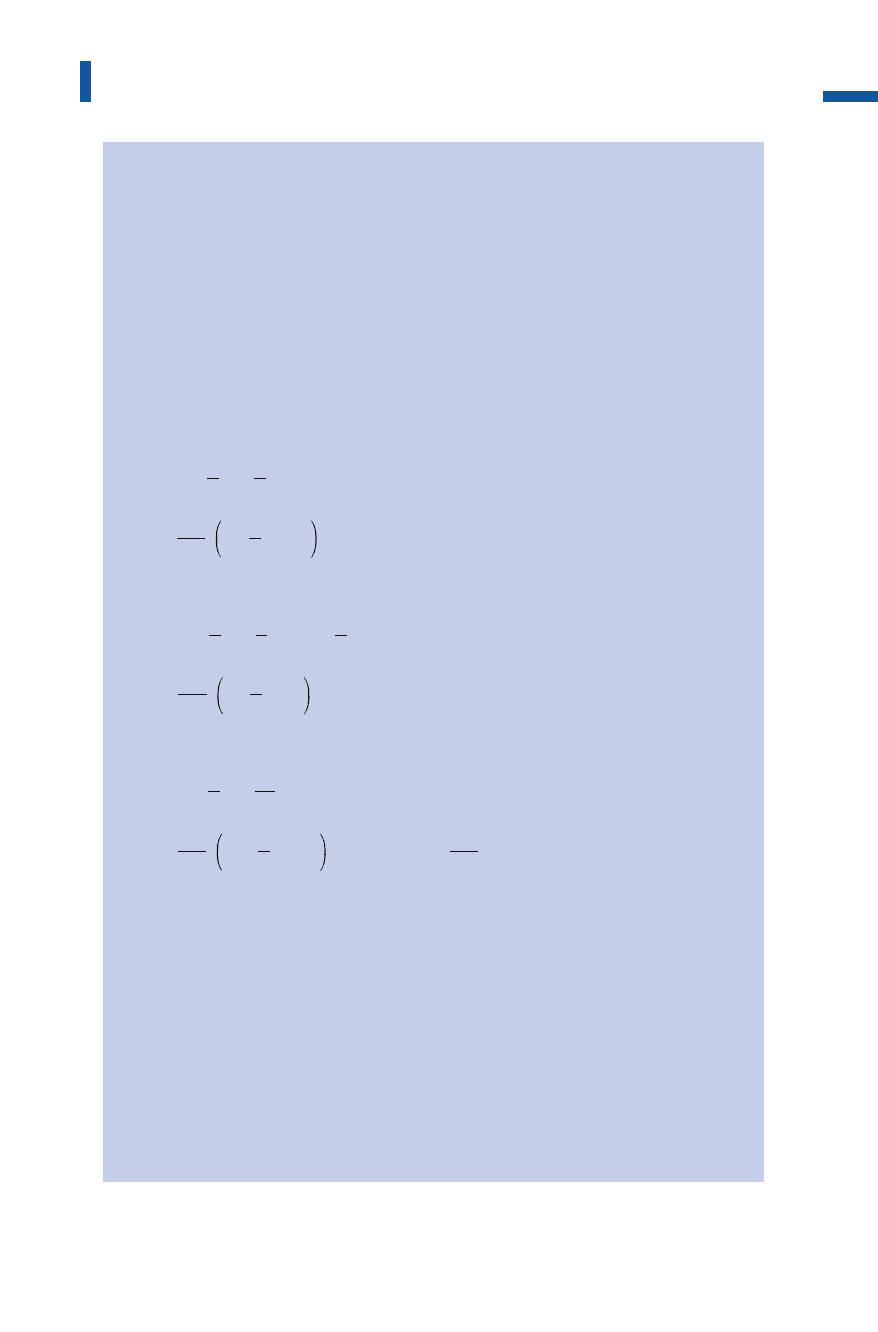
Example:
You wish to bend a piece of 3 mm thick sheet metal made of St 37-2, material
number 1.0037, in accordance with Fig.4.8.4.The minimum tensile strength
for this material is R
m
= 360 N/mm
2
. Using Table 4.8.1 it is accordingly possible
to determine the smallest permissible bending radius at r
i min
= 3 mm. To cal-
culate the blank length of the sheet metal part, we require the sum of the leg
lengths and all the relevant compensation values v, using the appropriate cor-
rection factor k for each case.
Sum of the leg lengths:
371
Bending
abcd mm
rmmsmm
k
vmm
rmmsmm
k
+++=+++=
=°= =
=+⋅=
=⋅⋅+⋅
⋅+
(
)
=
=°= =
=+⋅
30607520185
90 5 3
065
1
2
5
3
0761
90
180
5
3
2
0761 253 635
45 3 3
065
1
2
1
1
2
for
for
β
π
β
, , :
. log .
.– –.
, , :
.
loglog . log . .
.– –.
, , :
. log .
.–
3
3
065
1
2
10650 065
135
180
3
3
2
065 233 263
135 10 3
065
1
2
10
3
0911
45
180
10
3
2
0911 2
2
3
3
=+=+=
=⋅⋅+⋅
⋅+
(
)
=
=°= =
=+⋅=
=⋅⋅+⋅
⋅
vmm
rmmsmm
k
v
π
β
π
for
10103
45
2
0251136626 225 184
635263184 1082
1 185108217418
123
+
(
)
⋅
°
=
=⋅ ⋅ ⋅ °=
=++
==
=++++= =
tan
. . – tan . –.
–.–.–. –.
–. .
π mm
vvvv
vmm
The total extended length adds up to:
abcdv mm
ges
ges
ges
The sum of the compensation values amounts to:
The result is rounded up to the next higher millimeter,
resulting in a final blank dimension of 175 mm.
Metal Forming Handbook / Schuler (c) Springer-Verlag Berlin Heidelberg 1998
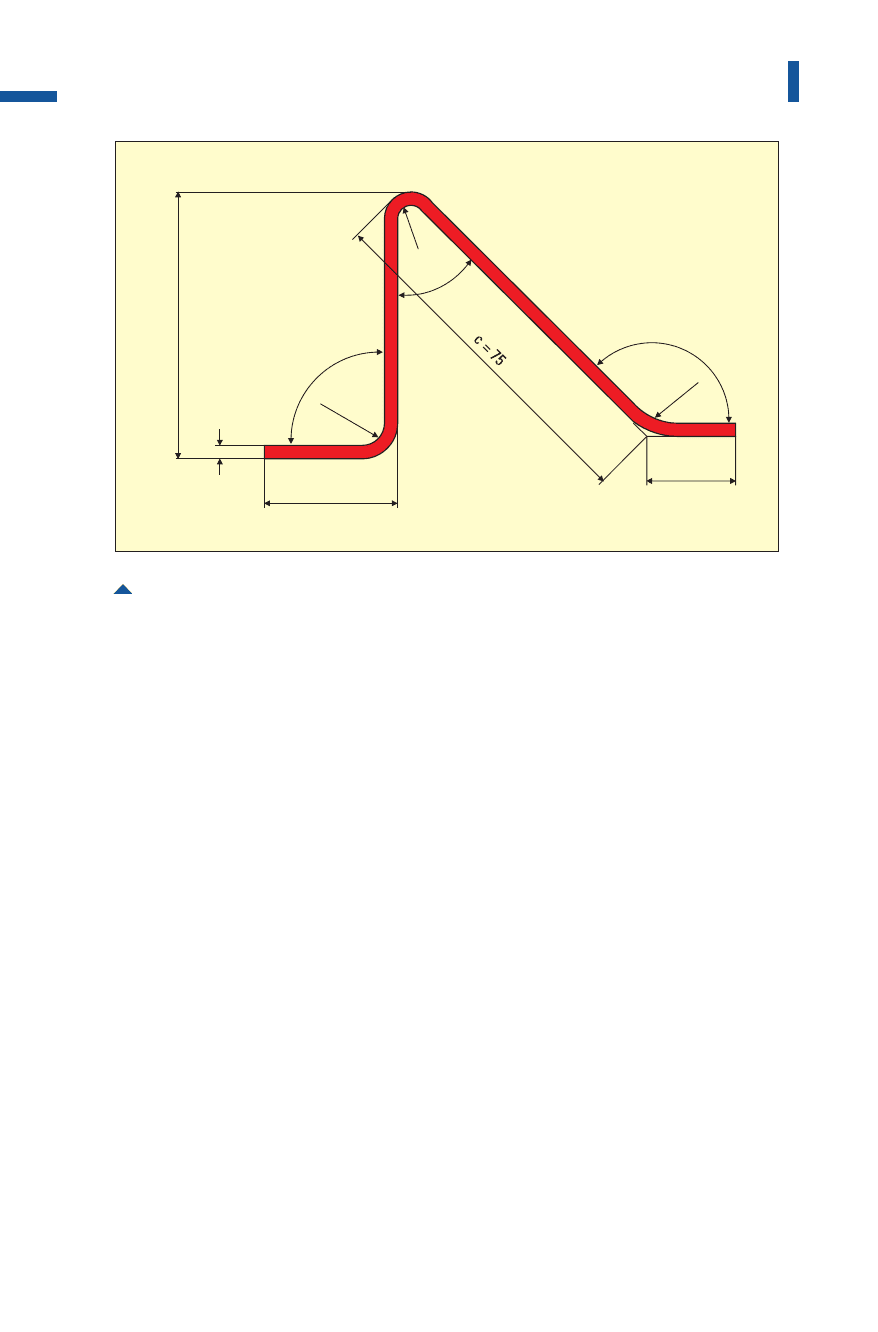
Bending force and bending work during V-die bending
V-die bending is a production technique that is widely used. Here, bend-
ing takes place between the bending punch and die (Fig. 4.8.5). This is
generally followed by the application of pressure on the die, which
serves to relieve residual stresses (reducing springback).
When bending angles in the V-die, the bending force F
b
[N] required
for forming depends on the die width w [mm], as this determines the
bending moment. In contrast to this, the magnitude of the bending
radius plays only a minor role, provided that the corresponding die
width w has been correctly selected. Generally speaking, the dimension
l[mm] of the die is selected in accordance with the sheet metal thickness
s[mm]:
When using a conventional die in which the sheet metal is positioned
at a distance w on both sides while the punch presses centrally onto the
sheet metal, with a coil stock width of b
S
[mm] the following bending
force is obtained:
372
Sheet metal forming and blanking
Fig. 4.8.4 Bent workpiece (cf. example)
d=20
3
9
0
°
5
3
4
5
°
1
3
5°
1
0
b
=
60
a=30
lsmm=⋅
[]
6
Metal Forming Handbook / Schuler (c) Springer-Verlag Berlin Heidelberg 1998
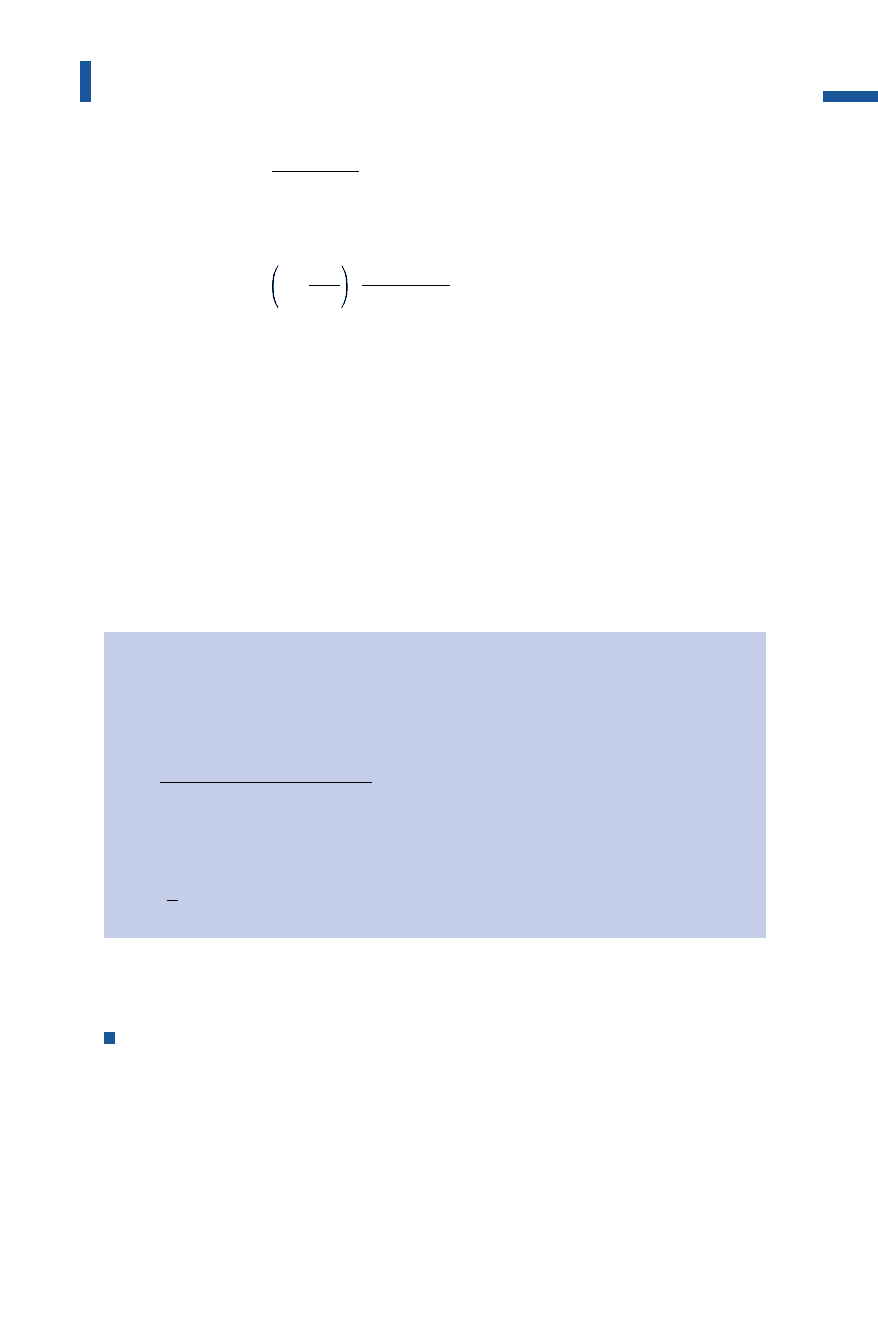
These are simplified formulae which, however, are sufficient in prac-
tice for approximate calculations. The bending work W
b
[Nm] amounts
to:
if the path of the punch from impact with the sheet metal until the end
of the bending process is designated as h [m]. The constant value x
takes into account the uneven force progression along the path of the
punch and generally lies between x = 0.3 and 0.6, depending on bend-
ing requirements and machine setting.
Example:
If a 2 mm thick aluminium sheet AlMg5Mn measuring 50 mm wide with a min-
imum tensile strength of R
m
=280 N/mm
2
is bent in a V-die with a width of
w = 15mm using a punch displacement of h = 7mm, the resulting bending force
is:
When bending using a V-die, the process factor x = 1/3. The bending work thus
amounts to:
4.8.2Roll forming and variety of sections
Process
Roll forming is categorized according to DIN 8586 as a method of form-
ing by bending using a rotary die motion (cf.Fig.2.1.3). During roll
forming, the sheet coil or blank is formed in a stepless and continuous
373
Bending
F
bsR
w
Nws
F
s
w
bsR
w
Nws
b
sm
b
sm
=
⋅⋅
[]
≥
=+
⋅
⋅
⋅⋅
[]
<
2
2
10
1
4
10
for
or
for
/
/
WxFhNm
bb
=⋅⋅
[]
,
F
mm mm Nmm
mm
N
b
=
⋅⋅
=
50 4 280
15
3733
22
/
,
W NmNmJ
b
=⋅ ⋅ = =
1
3
3733 0007 87 87,...
Metal Forming Handbook / Schuler (c) Springer-Verlag Berlin Heidelberg 1998
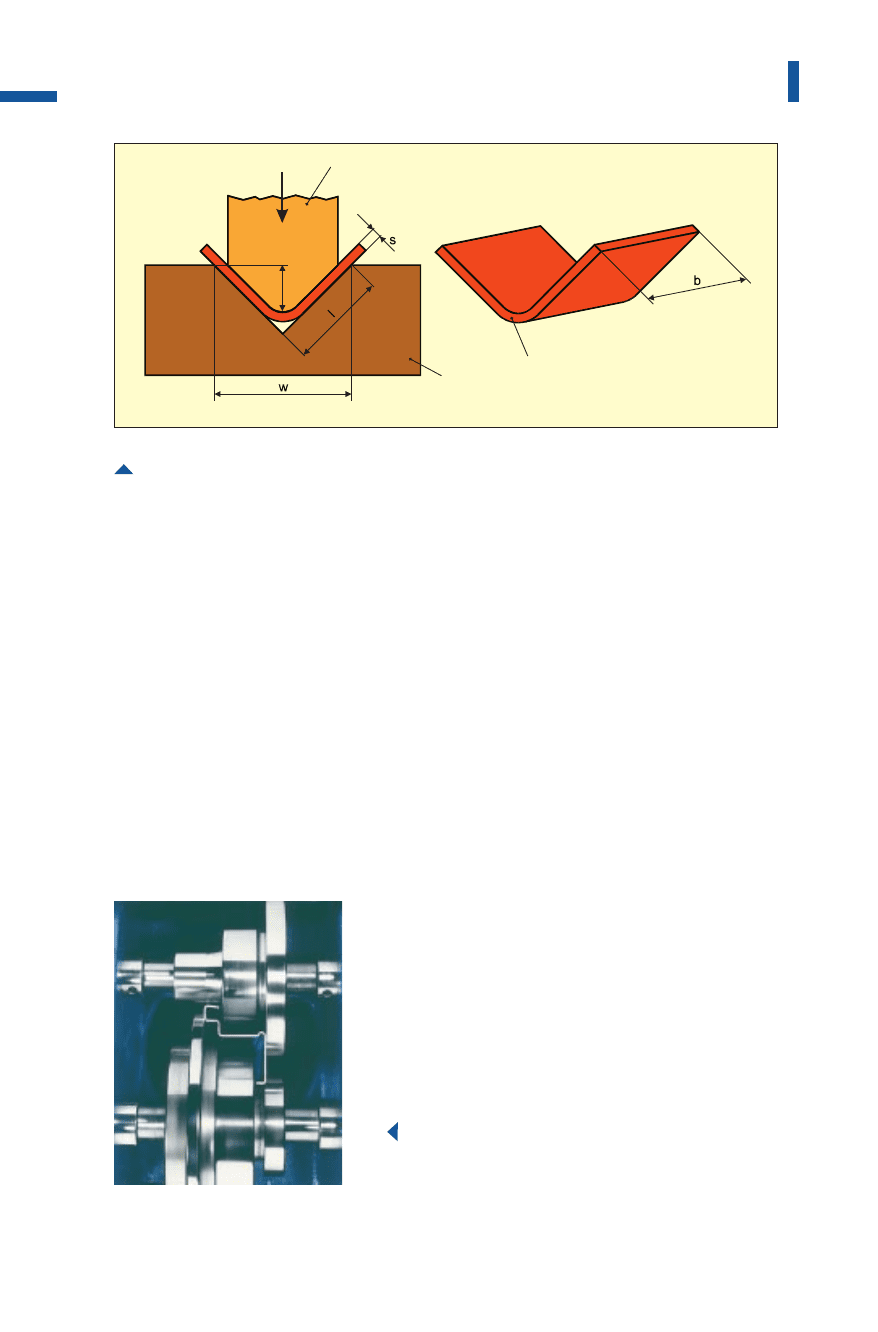
process to create profiles with the aid of rollers (Fig.4.8.6). One pair of
rollers is required per forming stage (Fig.4.8.7). The advantage of the
shaping process, compared to other bending methods, is that sheet strips
of any length can be formed at a relatively high speed.
Basic section geometries
Sections are manufactured in steps using a combination of simple basic
roll forms:
–Rolling:The edge of a profile is shaped by more than 180°. Three dif-
ferent configurations are most commonly used (Fig.4.8.8).
374
Sheet metal forming and blanking
Fig. 4.8.5 Bending in the V-die
h
die
punch
workpiece
Fig. 4.8.6
Pair of forming rolls:
last forming stage
Metal Forming Handbook / Schuler (c) Springer-Verlag Berlin Heidelberg 1998
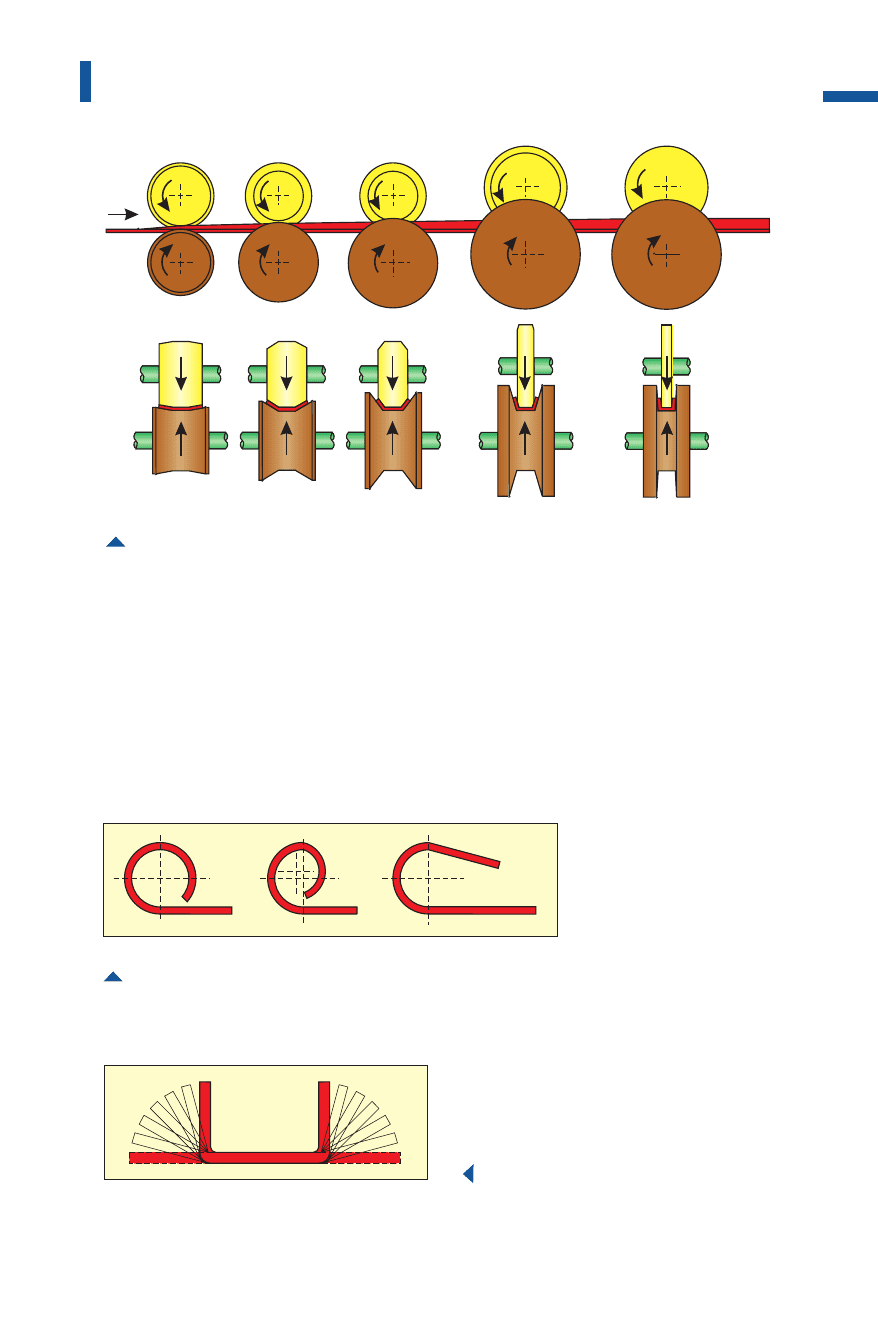
–Folding:step-by-step bending of straight legs around a common point
(Fig.4.8.9).
–Beading: recesses in the profile, e.g. for reinforcement (Fig.4.8.10).
–Doubling:The material is doubled back on itself, for example at the
edges (Fig. 4.8.11).
375
Bending
Fig. 4.8.8 Rolling:aeye: circular shape with only one radius;boval: circular shape, made
up of several radii;cloop: material not entirely bent over
ab c
Fig. 4.8.7 Roll forming: roll bending in several stages
Fig. 4.8.9Folding
Metal Forming Handbook / Schuler (c) Springer-Verlag Berlin Heidelberg 1998
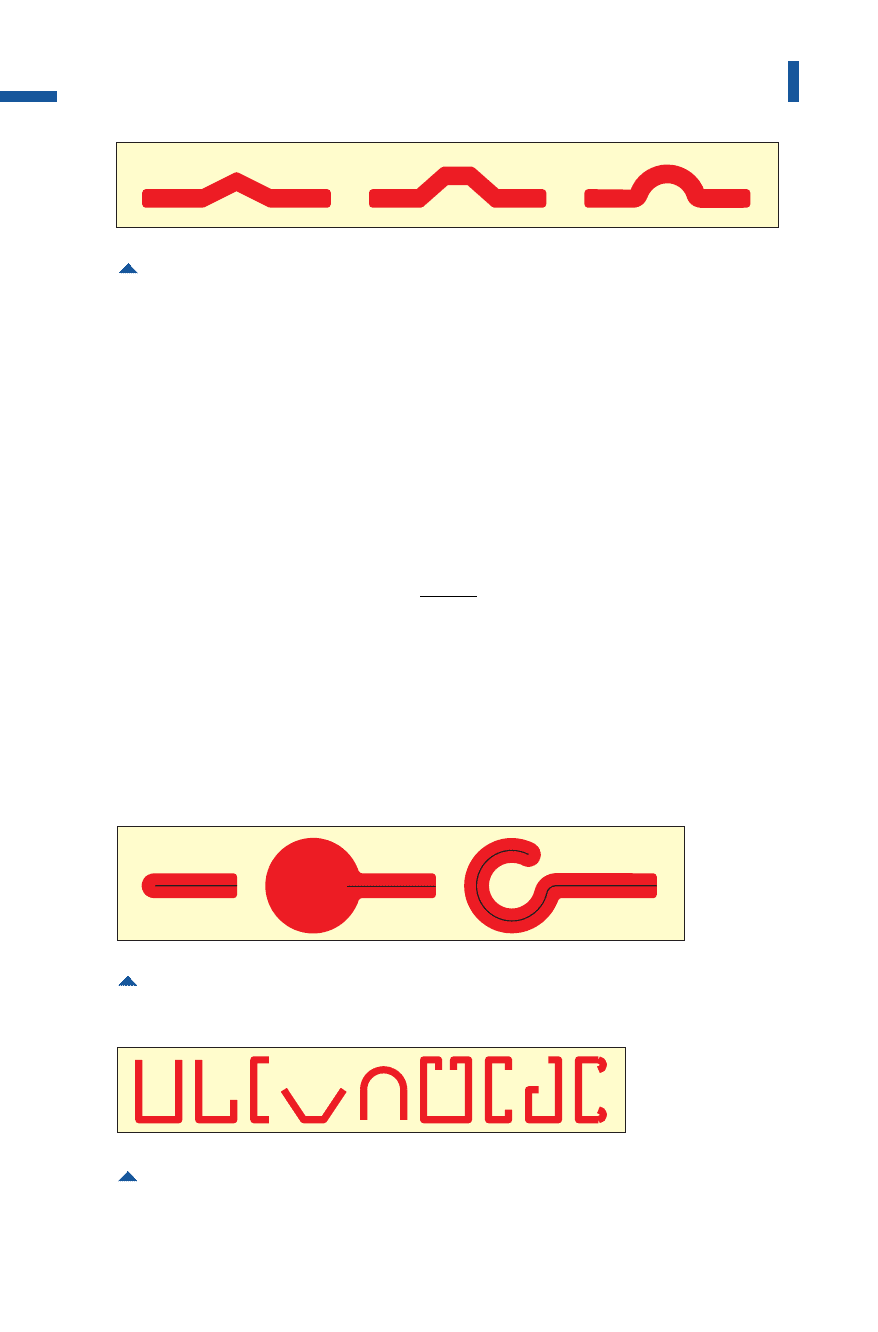
Application examples
By combining the basic shapes, it is possible to manufacture any option-
al section(Fig. 4.8.12to 4.8.17).Figure 4.8.18illustrates the step-by-step
manufacture of a special section geometry.
Roll bending radius
During the roll bending process, the actual bending radius must be
between the maximum and the minimum admissible bending radius:
with the modulus of elasticity E [N/mm
2
], the yield strength R
eL
or R
p0,2
[N/mm
2
] (cf.Sect.4.2.2) and the material coefficient c [–] in accordance
with Table 4.8.3.
376
Sheet metal forming and blanking
Fig. 4.8.10 Beading
Fig. 4.8.11 Doubling
Fig. 4.8.12 U/C and rail sections
r
sE
R
mm
rsc
i
eL
i
max
min
=
⋅
⋅
[]
=⋅
2
Metal Forming Handbook / Schuler (c) Springer-Verlag Berlin Heidelberg 1998
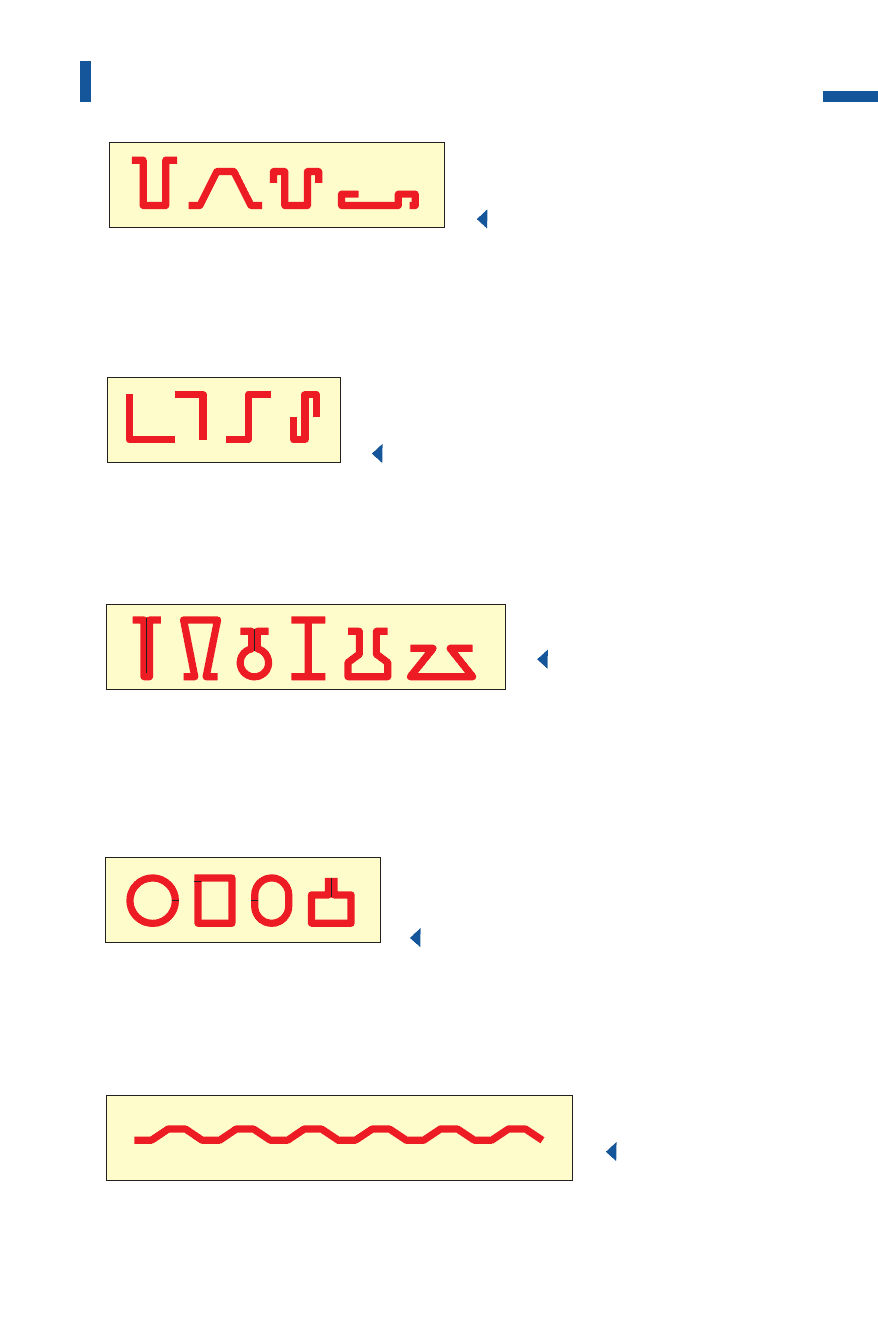
377
Bending
Fig. 4.8.13 Hat sections
Fig. 4.8.14 Angular, L and Z sections
Fig. 4.8.15
T and omega sections
Fig. 4.8.17
Wide strip sections
Fig. 4.8.16 Closed sections
Metal Forming Handbook / Schuler (c) Springer-Verlag Berlin Heidelberg 1998
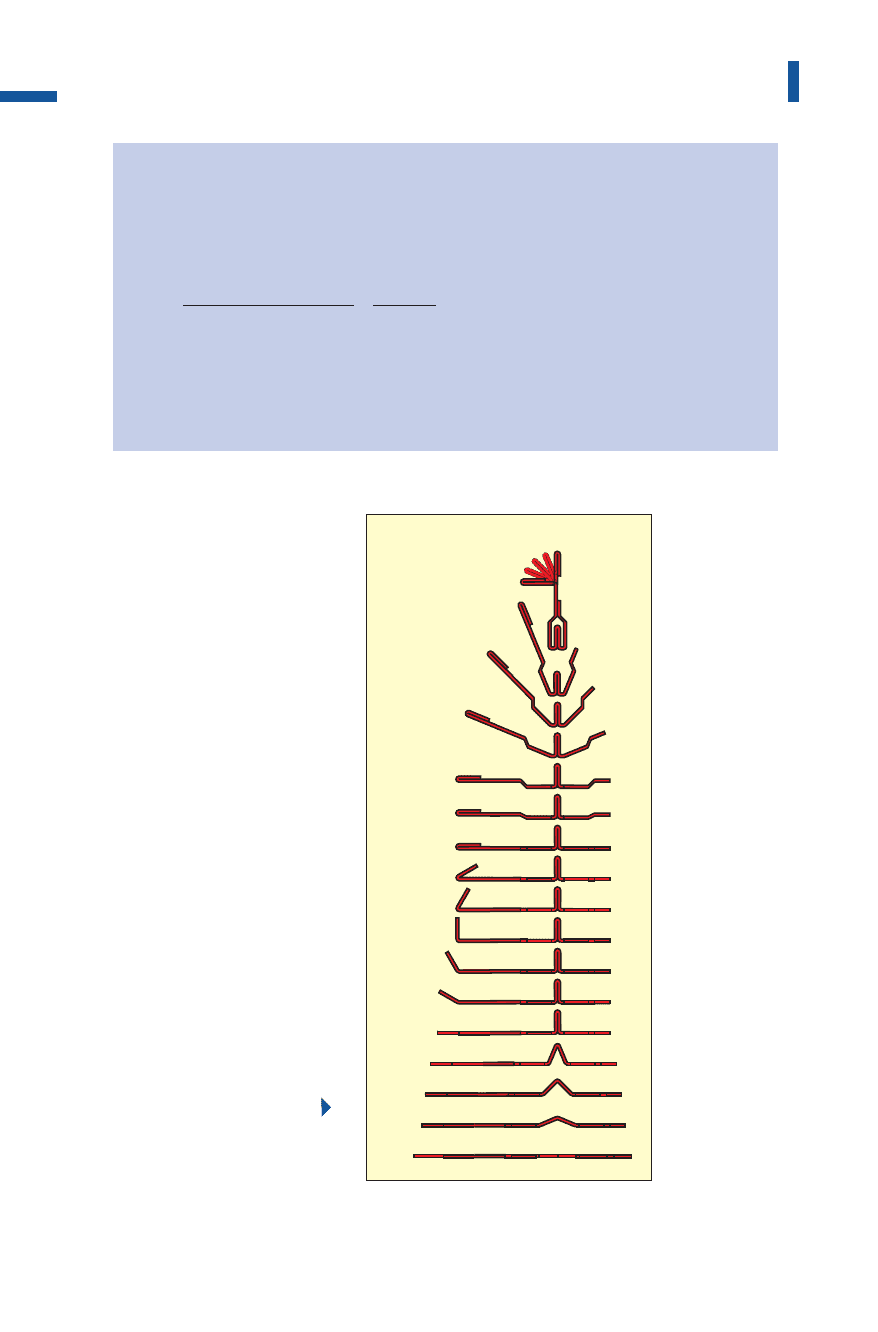
Example:
When roll forming with 2 mm thick strain hardened sheet steel in St 37-2
(material number 1.0037) with the modulus of elasticity E = 2.1 · 10
5
N/mm
2
for
steel and yield strength R
eL
= 220…240 N/mm
2
the useful radius range is calcu-
lated as follows:
The actual radius when bending at right angles to the rolling direction should
thus be at least 1 mm in size.
378
Sheet metal forming and blanking
r
mm N mm
Nmm
mm mm
rmm mm
i
i
max
min
./
/
,
.
=
⋅⋅
⋅
==
=⋅=
22110
2 240
210 000
240
875
2051
52
2
1
2
3
4
5
6
7
8
9
10
11
12
13
14
15
16
20
19
18
17
Fig. 4.8.18
Step-by-step manufacture of
a section using 20 rolls
(flower diagram)
Metal Forming Handbook / Schuler (c) Springer-Verlag Berlin Heidelberg 1998
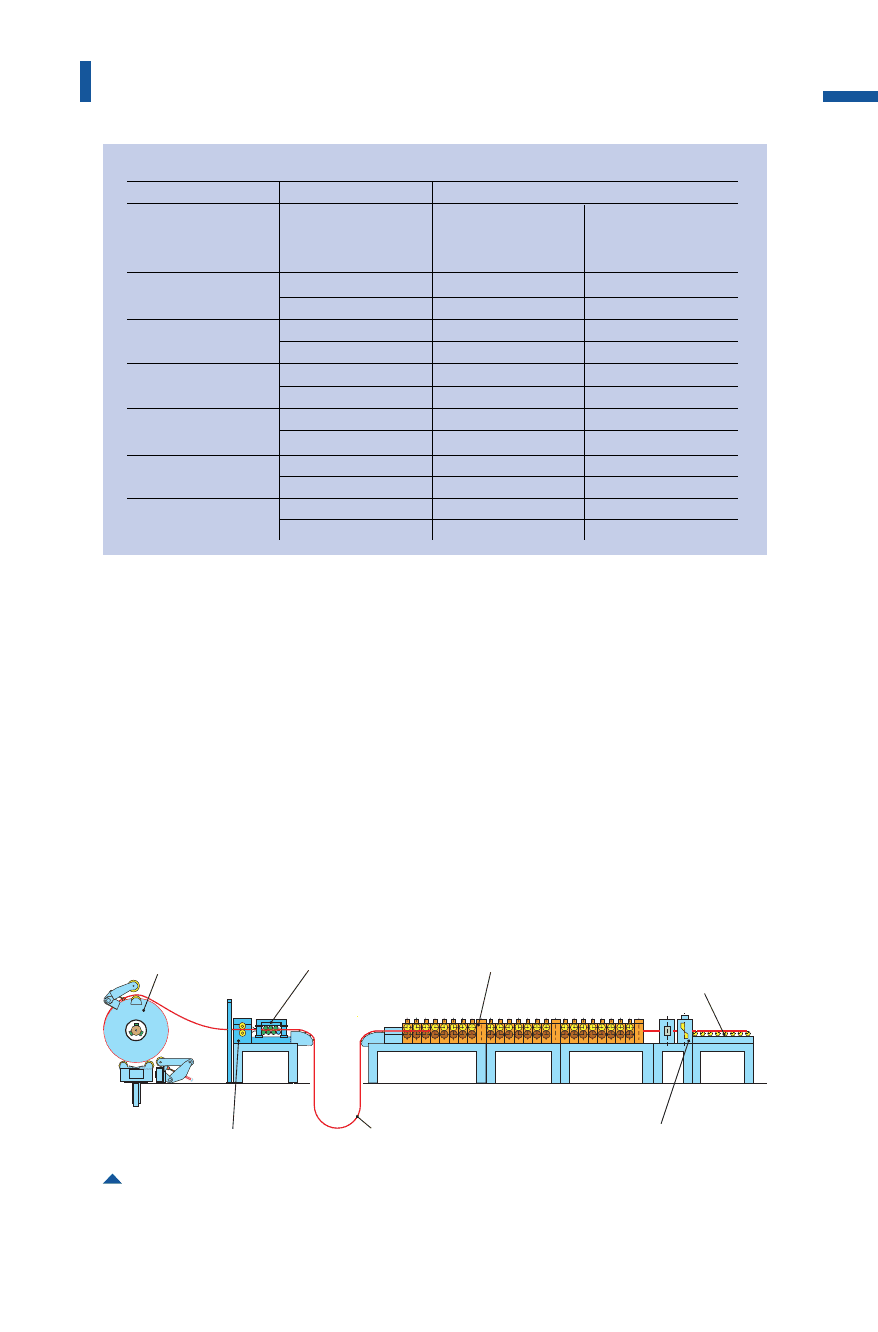
Roll forming lines
Roll forming lines are classified according to two different operating
modes. Start-stop lines consist in their simplest form of a decoiler, a coil
loop, a roll forming machine and a parting die. The product length is
determined by the roll forming machine (Fig. 4.8.19).Due to the use of
the start-stop method, blanking and embossing operations are also pos-
sible using the roll forming machine's positioning system.
Continuous running roll forming linesoperate at a constant speed. This
type of line is used to process sheet metal blanks or strips to create long
sections. While on blank processing lines cut-to-length blank metal
379
Bending
Table 4.8.3: Material coefficient c for the calculation of r
i min
Material coefficient c
Material
Bending direction
compared to rolling
direction of sheet
Material soft
annealed
Material strain
hardened
Al transverse 0.01 0.30
longitudinal 0.30 0.80
Cu transverse 0.01 1.00
longitudinal 0.30 2.00
Ms 67, Ms 72,
transverse 0.01 0.40
CuZn 37 longitudinal 0.30 0.80
St 13
transverse 0.01 0.40
longitudinal 0.40 0.80
C 15 – C 25
transverse 0.10 0.50
St 37 – St 42 longitudinal 0.50 1.00
C 35 – C 45
transverse 0.30 0.80
St 50 – St 70 longitudinal 0.80 1.50
Fig. 4.8.19 Start-stop roll forming line
decoiler with coil
infeed unit coil loop
roll forming machinestraightening machine outfeed
roller conveyo
r
parting device
Metal Forming Handbook / Schuler (c) Springer-Verlag Berlin Heidelberg 1998

sheets are processed, when using a sheet strip processing line the pro-
duced profile is parted after roll forming using automatic cut-to-length
devices.
The advantage of a blank processing line is that the complex pro-
file parting die can be substituted by a simple cross-cutting shear. This
eliminates the need for costly die inserts, a particularly important con-
sideration where different profile shapes or widths are being processed.
However, a further point of consideration is that this method requires a
certain minimum sheet length, as the feed force of the rollers must
always be greater than the torque necessary for the forming process
which has to be overcome. Furthermore, adequate provision must be
made to ensure efficient blank guidance.
The benefit of a continuously operating line producing off the coil is
its higher output when processing greater profile lengths. This produc-
tion method is essential if continuously running processes such as lon-
gitudinal seam welding, gluing, foaming, etc. have to be integrated dur-
ing profiling, or where with respect to the machine size excessive mass-
es would have to be accelerated.
In practice, the basic forms of this processing technique are fre-
quently upgraded, either due to insufficient output or because addi-
tional punched patterns have to be taken into consideration. In this
case, double loop lines with a separate punching device are used.
To keep set-up times to a minimum, roll forming lines are frequently
equipped with dual swivel-mounted decoilers capable of accommodat-
ing two coils and coil end welding machines. The coil end welding
machines join the end of the previous coil to the start of the next one,
saving not only the time required for feeding in a new coil but also
reducing the amount of scrap generated at the start and end of each coil.
Die changeover techniques with roll stand sets and rolling dies
To allow different section shapes to be manufactured on a single pro-
duction line, various roll changeover techniques are available. The
rolling dies are mounted on rigid stands or on stands with telescopic
roll set or directly mounted on the gear blocks (Fig.4.8.20).The stands
are connected to the gear units of the roll forming machine by means
of universal joint driven cardan shafts.
Width adjustable roll setspermit the manufacture of products with dif-
ferent web widths and leg heights using a common roll set (Fig. 4.8.21).
380
Sheet metal forming and blanking
Metal Forming Handbook / Schuler (c) Springer-Verlag Berlin Heidelberg 1998
